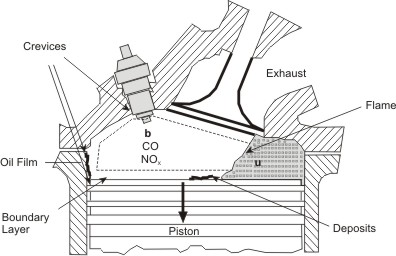| |
Emission Formation in SI Engines
Origin of SI engine exhaust emissions is shown schematically in Fig 2.1.

| Figurer. 2.1 |
Schematic of progress of combustion in SI engine and pollutant formation |
NOx and CO are formed in the burned gases in the cylinder. Unburned HC emissions originate when fuel escapes combustion due to several processes such as flame quenching in narrow passages present in the combustion chamber and incomplete oxidation of fuel that is trapped or absorbed in oil film or deposits
- NOx is formed by oxidation of molecular nitrogen. During combustion at high flame temperatures, nitrogen and oxygen molecules in the inducted air breakdown into atomic species which react to form NO. Some NO2 is also formed and NO and NO2 together are called as NOx.
- CO results from incomplete oxidation of fuel carbon when insufficient oxygen is available to completely oxidize the fuel. CO rises steeply as the air-fuel (A/F) ratio is decreased below the stoichiometric A/F ratio.
- HC originates from the fuel escaping combustion primarily due to flame quenching in crevices and on cold chamber walls, fuel vapour absorption in the oil layer on the cylinder and in combustion chamber deposits, and presence of liquid fuel in the cylinder during cold start
Air-fuel ratio is one of the most important parameter that affect the engine exhaust emissions. Typical variation in emissions with air-fuel ratio for premixed charge SI engines is shown in Fig. 2.2. The SI engine is operated close to stoichiometric air-fuel ratio as it provides a smooth engine operation. Nitric oxide emissions are maximum at slightly (5-10 %) leaner than stoichiometric mixture due to combination of availability of excess oxygen and high combustion temperatures at this point. Carbon monoxide and HC emissions reduce with increase in the air-fuel ratio as more oxygen gets available for combustion. Lean engine operation to a certain critical value of air-fuel ratio tend to reduce all the three pollutants. Further leaning of mixture results in poor quality of combustion and eventually in engine misfiring causing an erratic engine operation and sharp increase in HC emissions. Normally, one would like to operate engine on lean mixtures that would give low CO and HC, and moderate NOx emissions. But, presently most engines are operated very close to stoichiometric conditions for catalytic control of NOx emissions,

| Figure 2.2 |
Variation in CO, HC and NOx emissions for a SI engine |
|